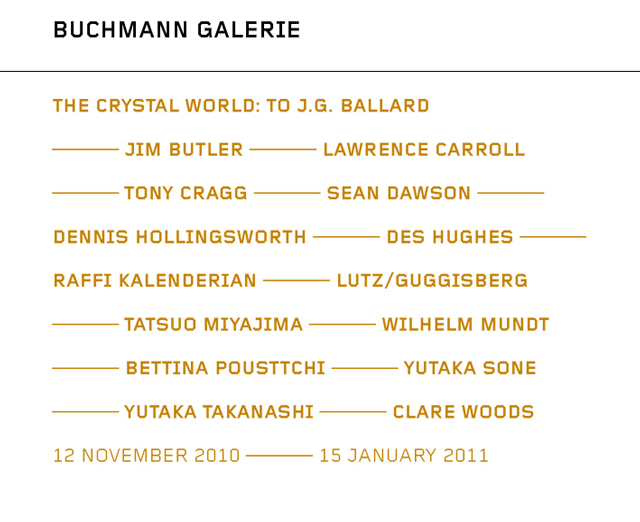November 12, 2010
CRYSTAL WORLD

I'm honored to be included in CRYSTAL WORLD, an exhibition created by my gallery in Berlin, BUCHMANN GALERIE. Here is the press release:
Curated by Andr? BuchmannPosted by Dennis at November 12, 2010 9:23 PMThe British writer J. G. Ballard (1930?2009) is the author of such great science fiction novels as The Drowned World, Crash, and Concrete Island. Many of his texts depict scenarios of the end of the world that do not describe the causes but only the events and the degeneration of society when faced with its end.
J. G. Ballard sketches a far less gloomy picture in his 1966 novel The Crystal World. A mysterious and dramatic biological change transforms plants, animals, and people in the jungle of Gabon into glowing crystalline structures; the novel?s real theme, however, is how the crystals transform time. One of the characters in the novel deliberately chooses to remain behind and crystallize in order to survive, avoiding death from an incurable disease.The exhibition brings together works by fifteen artists that are related in some way to this novel.
The artists Lutz/Guggisberg, who since 1996 have been working as a duo, have an unusual connection to literature through their imaginary library. As soon as we read the titles, authors? names, and publishers of their books, we imagine a story. With Lutz/Guggisberg?s books, the plot is created in the viewer?s imagination. Their books cannot be read; they trust in the power of the imagination.The Worm Returns is an early sculpture by Tony Cragg. As scientific visual aids, models of sulfur, polyethylene, and alcohol molecules help make a world visible that would otherwise escape visual perception. Do these models thereby result in a deeper understanding of our world?s objects and their inner structures? Sulfur molecules, for example, can form various crystal structures. Dr. Sanders, the protagonist of Ballard?s novel, is a scientist, and initially he seeks rational explanations for the continued crystallization and solidification of the jungle.
Wilhelm Mundt?s transparent glass sphere could also be an explanatory model for the crystal world. A massive layer of transparent glass surrounds like protective armor a red clump of material. Is it a meteorite providing clues about the origins of our earth and its ever crystallizing inner core of iron and nickel, or is it a biological pathogen that has caused the breakdown of time?
The two sculptures by Des Hughes also seem like fragments of a meteorite. Their matte surfaces contrast with golden intarsia from an unknown precious material or culture.
The crystallized jungle is declared a military restricted area, though it remains accessible at your own risk. The fragile and porous borders?understood in a political, social, and personal sense as well?are reflected in Bettina Pousttchi?s sculpture Cleared of transparent glass. The sculpture was presented at the Venice Biennale in 2009.
The fragile aspect of Bettina Pousttchi?s work is continued by Tatsuo Miyajima in his work about time, space, and primary colors (from which every other color can be produced). Diamond in You refers to the personal change in the protagonists of The Crystal World. In the end, Dr. Sanders does find himself, but he chooses the path into the crystallized, glowing jungle, and hence his death, like the blank space in Tatsuo Miyajima?s cyclical series of numbers.
Cautiously walking on tiptoes, the figure in Transparent Girl by Jim Butler dissolves in white light. The female body?is it Suzanne Clair of the novel??is now only a fragile shell that has already begun to mutate into a crystalline form. As a pendant to it, a painting by Raffi Kalenderian depicts a male protagonist with two pairs of eyes, representing inner and outer vision. Can he perceive the inconceivable?
Lawrence Carroll?s Snowballs recall the reliquaries covered with shimmering crystals that dealers pilfered from the solidified jungle to sell at the market in Port Matarre. In his photographs and drawings of snowflake crystals, Yutaka Sone turns an analytical eye on the inner structures of the glittering splendor that Yutaka Takanashi finds in 1970s Tokyo. His photographs from Towards the City reveal the megacity in all its facets. They are the summit of the Provoke movement, which in the late 1960s and early 1970s revolutionized Japanese photography with its raw, ephemeral, and expression manner.
J. G. Ballard was frequently a source of inspiration for pop musicians, such as Ultravox and Ian Curtis of Joy Division. Sean Dawson often refers to the novels of J. G. Ballard in the titles of his paintings. His dense, painterly compositions correspond to Ballard?s own dense language, making them thoroughly ?Ballardian.?
The jungle, with its prismatic colors, flickering lights, and flowing forms, is captured by Clare Woods in her watercolors and in the paintings of Dennis Hollingsworth, which recall microbiological and vegetal worlds with an inherent, ambiguous beauty.I would like to use this opportunity to thank sincerely all the artists for agreeing to participate, supporting, and providing works for this exhibition. In numerous conversations, I have found astonishing parallels between the works of the artists invited and J. G. Ballard?s novel.
A.B., October 2010
BUCHMANN GALERIE BERLIN
Charlottenstrasse 13
D - 10969 Berlin
T. +49-30-258 999 29
F. +49-30-258 999 39
info@buchmanngalerie.com
www.buchmanngalerie.com
Tue?- Sat 11am - 6pm
Leave a comment